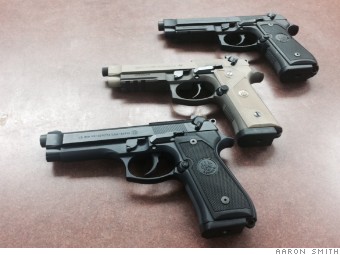

Sights on service models are of fixed type, with a dovetailed rear blade, usually with high-contrast inserts.

Magazines are double stack, with the magazine release button located in the base of the trigger-guard on all 92-series pistols made since 1981. Some other models, such as the Model 92D, are double-action-only (DAO) pistols with no manual safety or decocker.Īll pistols of current production are fitted with an automatic firing pin block safety. On some pistols, such as the Model 92G adopted in France, the levers do not lock themselves in the lowered position but return to the “fire” position once released – their function is limited only to safe decocking of the hammer. Original Model 92 pistols had a frame-mounted safety which was applied only when the hammer was cocked all subsequent pistols (except for some limited production civilian-only sporting models) either had a slide-mounted safety lever or no safety lever at all. The trigger is Single action/ Double action, with an exposed hammer. The locking system is of the Walther type, with a vertically-tilting locking piece located below the breech area of the barrel. Beretta also makes a wide variety of models based on the same design these include not only variations in finishes and sights, but also different trigger types (DA/SA, DA/SA with decock only, DAO, DAO with manual safety).īeretta 92FS field stripped into major partsīeretta 92 pistols are short-recoil operated, locked-breech weapons with an aluminium frame. 40 S&W (model 96) and 9x21 IMI (Model 98, available for civilian users in certain European countries, including Italy). Other than the basic 9mm, Beretta also makes these pistols in other calibers, such as. It must be noted that, while being entirely adequate as a combat pistol, the Beretta 92 is somewhat bulky for its caliber and magazine capacity, thus less suitable for users with average or smaller hands. In the late 1980s and 1990s, these pistols were also adopted in France.


The US military adopted the Model 92SB-F (later renamed to model 92F) in 1985, as a result of the highly controversial XM9 trials. It was developed between 19 as a possible replacement for the aging Beretta M951 pistol, and entered production in Italy in 1976.įirst adopted by the Brazilian army in 1977, this pistol was later adopted in Italy in its Model 92S, “SB”, and finally “F” modifications. Originally designed for the Italian army and police, the Model 92 pistols earned most of their fame (both good and bad) as the standard sidearm of the US military.


 0 kommentar(er)
0 kommentar(er)
